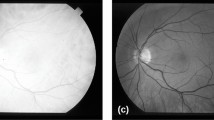Abstract
Retinal images are playing a very significant role in medical imaging technology. The variation in blood vessel attributes like tortuosity, focal length, branching angle, deformations like haemorrhage, lesions, etc. are good indicators of many diseases. Therefore, identifying these changes and distortions precisely can assist the ophthalmologists to detect and diagnose many diseases like diabetes, hypertension, glaucoma, stroke, etc. even in the early stage. Segmenting the vessel network is the preliminary step in the automation of the disease diagnosis process. The computerization of this segmentation process reduces the time, cost, and inconsistency due to manual segmentation. Here we present an automatic vessel segmentation technique. The proposed approach enhances the image contrast and highlights the edges using a novel cascaded pre-processing stage. In addition to this, a novel thresholding method named Mean Global Based on Hysteresis (MGBH) is introduced for segmentation. The efficiency of the suggested scheme is evaluated on the DRIVE database. The results are compared with state-of-the-art methods. The proposed method achieves better performance parameter values. The advantages of the proposed method include fast processing and high segmentation accuracy with simplified implementation. Moreover, this work can be extended to segment noisy and diseased fundus images.







Similar content being viewed by others
Data Availability
Not applicable.
Code availability
No.
References
Aslani S, Sarnel H (2016) A new supervised retinal vessel segmentation method based on robust hybrid features. Biomedical Signal Processing and Control 30:1–12. https://doi.org/10.1016/j.bspc.2016.05.006
Bandara AMRR, Giragama PWGRMPB (2017). A retinal image enhancement technique for blood vessel segmentation algorithm. In 2017 IEEE international conference on industrial and information systems (ICIIS),IEEE: 1–5. https://doi.org/10.1109/iciinfs.2017.8300426
Canny JF (1983) Finding edges and lines in images. MIT Artificial Intelligence Lab., Cambridge, Rep. Al-TR-720
Chu K (1999) An introduction to sensitivity, specificity, predictive values and likelihood ratios. Emerg Med 11(3):175–181. https://doi.org/10.1046/j.1442-2026.1999.00041.x
Dash J, Bhoi N (2017) A thresholding based technique to extract retinal blood vessels from fundus images. Future Computing and Informatics Journal 2(2):103–109. https://doi.org/10.1016/j.fcij.2017.10.001
Dash J, Bhoi N (2018) Retinal blood vessel segmentation using Otsu thresholding with principal component analysis. In 2018 2nd international conference on inventive systems and control (ICISC) IEEE: 933-937. https://doi.org/10.1109/icisc.2018.8398938
Dash J, Bhoi N (2019) Retinal blood vessel extraction using morphological operators and Kirsch’s template. In soft computing and signal processing, springer :603-611. https://doi.org/10.1007/978-981-13-3600-3_57
Dash S, Senapati MR, Sahu PK, Chowdary PSR (2021) Illumination normalized based technique for retinal blood vessel segmentation. Int J Imaging Syst Technol 31(1):351–363
Davies Machine Vision (1990) Theory. Academic Press, Algorithms and Practicalities, pp 91–96
GeethaRamani R, Balasubramanian L (2016) Retinal blood vessel segmentation employing image processing and data mining techniques for computerized retinal image analysis. Biocybernetics and Biomedical Engineering 36(1):102–118
Gonzalez RC, Woods RE, Eddins SL (2004) Digital image processing. Pearson Education India. https://doi.org/10.1016/b9
Heneghan C, Flynn J, O’Keefe M, Cahill M (2002) Characterization of changes in blood vessel width and tortuosity in retinopathy of prematurity using image analysis. Med Image Anal 6(4):407–429. https://doi.org/10.1016/s1361-8415(02)00058-0
http://www.isi.uu.nl/Research/Databases/DRIVE (2021) accessed in January, 2021
Imani E, Javidi M, Pourreza HR (2015) Improvement of retinal blood vessel detection using morphological component analysis. Comput Methods Prog Biomed 118(3):263–279. https://doi.org/10.1016/j.cmpb.2015.01.004
Imran A, Li J, Pei Y, Yang JJ, Wang Q (2019) Comparative analysis of vessel segmentation techniques in retinal images. IEEE Access 7:114862–114887. https://doi.org/10.1109/access.2019.2935912
Khan MA, Khan TM, Soomro TA, Mir N, Gao J (2019) Boosting sensitivity of a retinal vessel segmentation algorithm. Pattern Anal Applic 22(2):583–599. https://doi.org/10.1007/s10044-017-0661-4
Liao M, Zhao YQ, Wang XH, Dai PS (2014) Retinal vessel enhancement based on multi-scale top-hat transformation and histogram fitting stretching. Opt Laser Technol 58:56–62. https://doi.org/10.1016/j.optlastec.2013.10.018
Memari N, Saripan MIB, Mashohor S, Moghbel M (2019) Retinal blood vessel segmentation by using matched filtering and fuzzy c-means clustering with integrated level set method for diabetic retinopathy assessment. Journal of Medical and Biological Engineering 39(5):713–731. https://doi.org/10.1007/s40846-018-0454-2
Neto LC, Ramalho GL, Neto JFR, Veras RM, Medeiros FN (2017) An unsupervised coarse-to-fine algorithm for blood vessel segmentation in fundus images. Expert Syst Appl 78:182–192. https://doi.org/10.1016/j.eswa.2017.02.015
Nguyen UT, Bhuiyan A, Park LA, Ramamohanarao K (2013) An effective retinal blood vessel segmentation method using multi-scale line detection. Pattern Recogn 46(3):703–715. https://doi.org/10.1016/j.patcog.2012.08.009
Otsu N (1979) A threshold selection method from gray-level histograms. IEEE transactions on systems, man, and cybernetics 9(1):62–66
Pal S, Chatterjee S, Dey D, Munshi S (2019) Morphological operations with iterative rotation of structuring elements for segmentation of retinal vessel structures. Multidim Syst Sign Process 30(1):373–389. https://doi.org/10.1007/s11045-018-0561-9
Roychowdhury S, Koozekanani DD, Parhi K (2014) Blood vessel segmentation of fundus images by major vessel extraction and subimage classification. IEEE journal of biomedical and health informatics 19(3):1118–1128. https://doi.org/10.1109/jbhi.2014.2335617
Saleh S. A. M., & Ibrahim H. (2012). Mathematical equations for homomorphic filtering in frequency domain: a literature survey. In proceedings of the international conference on information and knowledge management :74-77. https://doi.org/10.1109/infrkm.2012.6205009
Sathya N, Karuppasamy K, Suresh P (2017) Contourlet transform and morphological reconstruction based retinal blood vessel segmentation. Int J Biomed Eng Technol 25(2–4):105–119. https://doi.org/10.1504/ijbet.2017.087710
Zhou C, Zhang X, Chen H (2020) A new robust method for blood vessel segmentation in retinal fundus images based on weighted line detector and hidden Markov model. Comput Methods Prog Biomed 187:105231. https://doi.org/10.1016/j.cmpb.2019.105231
Zuiderveld, K. (1994). Contrast limited adaptive histogram equalization. Graphics Gems, 474-485. https://doi.org/10.1016/b978-0-12-336156-1.50061-6
Author information
Authors and Affiliations
Corresponding author
Ethics declarations
Conflicts of interest/competing interests
On behalf of all authors, I Sakambhari Mahapatra, the corresponding author likes to state that there is no conflict of interest.
Additional information
Publisher’s note
Springer Nature remains neutral with regard to jurisdictional claims in published maps and institutional affiliations.
Rights and permissions
Springer Nature or its licensor holds exclusive rights to this article under a publishing agreement with the author(s) or other rightsholder(s); author self-archiving of the accepted manuscript version of this article is solely governed by the terms of such publishing agreement and applicable law.
About this article
Cite this article
Mahapatra, S., Jena, U.R. & Dash, S. Mean global based on hysteresis thresholding for retinal blood vessel segmentation using enhanced homomorphic filtering. Multimed Tools Appl 81, 41911–41928 (2022). https://doi.org/10.1007/s11042-022-13517-4
Received:
Revised:
Accepted:
Published:
Issue Date:
DOI: https://doi.org/10.1007/s11042-022-13517-4




